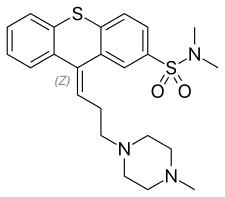Tiotixene
Tiotixene, or thiothixene, sold under the brand name Navane among others, is a typical antipsychotic of the thioxanthene class which is related to chlorprothixene and is used in the treatment of psychoses like schizophrenia and bipolar mania. It was introduced in the United States in 1967[1] by Pfizer.[2]
 | |
| Clinical data | |
|---|---|
| Trade names | Navane |
| Other names | Thiothixene (USAN US) |
| AHFS/Drugs.com | Monograph |
| MedlinePlus | a682867 |
| Pregnancy category |
|
| Routes of administration | By mouth |
| ATC code | |
| Legal status | |
| Legal status |
|
| Pharmacokinetic data | |
| Metabolism | Hepatic |
| Elimination half-life | 10–20 hours |
| Identifiers | |
| |
| CAS Number | |
| PubChem CID | |
| IUPHAR/BPS | |
| DrugBank | |
| ChemSpider | |
| UNII | |
| ChEMBL | |
| CompTox Dashboard (EPA) | |
| ECHA InfoCard | 100.233.356 |
| Chemical and physical data | |
| Formula | C23H29N3O2S2 |
| Molar mass | 443.62 g·mol−1 |
| 3D model (JSmol) | |
| |
| |
| (verify) | |
It's also related to thioproperazine and pipotiazine, members of the phenothiazine class.
Pharmacology
Pharmacodynamics
| Site | Ki (nM) | Species | Ref |
|---|---|---|---|
| SERT | 3,162–3,878 | Human | [3][4] |
| NET | 30,200 | Human | [3][4] |
| DAT | 3,630 | Human | [3][4] |
| 5-HT1A | 410–912 | Human | [3][5][4] |
| 5-HT1B | 151 | Human | [3] |
| 5-HT1D | 659 | Human | [3] |
| 5-HT1E | >10,000 | Human | [3] |
| 5-HT2A | 50–89 | Human | [5][4] |
| 5-HT2C | 1,350–1,400 | Human | [5][4] |
| 5-HT3 | 1,860 | Human | [3][4] |
| 5-HT5A | 361 | Human | [3] |
| 5-HT6 | 208–320 | Human | [3][5][4] |
| 5-HT7 | 15.5 | Human | [3][5][4] |
| α1 | 19 | ND | [4] |
| α1A | 11–12 | Human | [3][5] |
| α1B | 35 | Human | [3] |
| α2 | 95 | ND | [4] |
| α2A | 80 | Human | [3][5] |
| α2B | 50 | Human | [3][5] |
| α2C | 52 | Human | [3][5] |
| β1 | >10,000 | Human | [3] |
| β2 | >10,000 | Human | [3] |
| D1 | 51–339 | Human | [3][4] |
| D2 | 0.03–1.4 | Human | [3][5][6] |
| D3 | 0.3–186 | Human | [6][4] |
| D4 | 203–363 | Human | [3][4] |
| D4.2 | 410–685 | Human | [6] |
| D5 | 261 | Human | [3] |
| H1 | 4.0–12 | Human | [3][5][7] |
| H2 | 411 | Human | [3] |
| H3 | 1,336 | Guinea pig | [3] |
| H4 | >10,000 | Human | [3] |
| mACh | 3,310 | ND | [4] |
| M1 | ≥2,820 | Human | [3][4] |
| M2 | ≥2,450 | Human | [3][4] |
| M3 | ≥5,750 | Human | [3][5][4] |
| M4 | >10,000 | Human | [3] |
| M5 | 5,376 | Human | [3] |
| σ | 1,780 | ND | [4] |
| Values are Ki (nM). The smaller the value, the more strongly the drug binds to the site. | |||
Tiotixene acts primarily as a highly potent antagonist of the dopamine D2 and D3 receptors (subnanomolar affinity).[3] It is also an antagonist of the histamine H1, α1-adrenergic, and serotonin 5-HT7 receptors (low nanomolar affinity), as well as of various other receptors to a much lesser extent (lower affinity).[3] It does not have any anticholinergic activity.[3] Antagonism of the D2 receptor is thought to be responsible for the antipsychotic effects of tiotixene.
Chemistry
Tiotixene is a member of the thioxanthene class of antipsychotics. Analogues include chlorprothixene, clopenthixol, flupentixol, and zuclopenthixol.
References
- http://www.accessdata.fda.gov/scripts/cder/drugsatfda/index.cfm
- José Miguel Vela; Helmut Buschmann; Jörg Holenz; Antonio Párraga; Antoni Torrens (2007). Antidepressants, Antipsychotics, Anxiolytics: From Chemistry and Pharmacology to Clinical Application. Weinheim: Wiley-VCH. p. 520. ISBN 3-527-31058-4.
- Roth, BL; Driscol, J. "PDSP Ki Database" (HTML). Psychoactive Drug Screening Program (PDSP). University of North Carolina at Chapel Hill and the United States National Institute of Mental Health. Retrieved 14 August 2017.
- Silvestre JS, Prous J (2005). "Research on adverse drug events. I. Muscarinic M3 receptor binding affinity could predict the risk of antipsychotics to induce type 2 diabetes". Methods Find Exp Clin Pharmacol. 27 (5): 289–304. doi:10.1358/mf.2005.27.5.908643. PMID 16082416.
- Kroeze WK, Hufeisen SJ, Popadak BA, Renock SM, Steinberg S, Ernsberger P, Jayathilake K, Meltzer HY, Roth BL (2003). "H1-histamine receptor affinity predicts short-term weight gain for typical and atypical antipsychotic drugs". Neuropsychopharmacology. 28 (3): 519–26. doi:10.1038/sj.npp.1300027. PMID 12629531.
- Burstein ES, Ma J, Wong S, Gao Y, Pham E, Knapp AE, Nash NR, Olsson R, Davis RE, Hacksell U, Weiner DM, Brann MR (2005). "Intrinsic efficacy of antipsychotics at human D2, D3, and D4 dopamine receptors: identification of the clozapine metabolite N-desmethylclozapine as a D2/D3 partial agonist". J. Pharmacol. Exp. Ther. 315 (3): 1278–87. doi:10.1124/jpet.105.092155. PMID 16135699.
- Kanba S, Richelson E (1984). "Histamine H1 receptors in human brain labelled with [3H]doxepin". Brain Res. 304 (1): 1–7. doi:10.1016/0006-8993(84)90856-4. PMID 6146381.
- William Andrew Publishing (22 October 2013). Pharmaceutical Manufacturing Encyclopedia. Elsevier. pp. 3214–. ISBN 978-0-8155-1856-3.
- Edward Shorter (2009). Before Prozac: The Troubled History of Mood Disorders in Psychiatry. Oxford University Press, USA. pp. 51–. ISBN 978-0-19-536874-1.